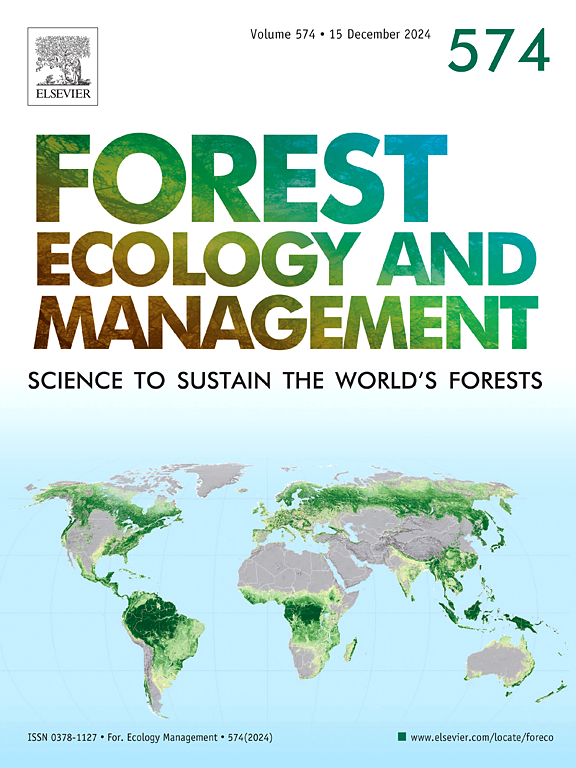遗产生态调查和物种分布模型揭示了20世纪中期美洲板栗(Castanea dentata [Marsh])生态位。),美国纽约州门罗县
IF 3.7
2区 农林科学
Q1 FORESTRY
引用次数: 0
摘要
美洲板栗(Castanea dentata)[沼泽。在20世纪早期,由于真菌枯萎病的侵袭,这种树在美国东部森林中一直是一种重要的树木。回交育种和基因工程的努力一直在寻求开发一种抗枯萎病的品种。为了预测物种的恢复,研究人员开发了物种分布模型(SDMs)来模拟适合栖息地的潜在位置。SDMs要么模拟了前欧洲、美洲,要么模拟了该物种现在的分布。本研究利用1938-1940年进行的全县生态调查的独特数据集,模拟了20世纪中期美国纽约州门罗县板栗的分布。采用最大熵技术,本研究以10 m分辨率模拟了与土壤和地形预测因子相关的分布。该研究建立了良好的模型(即平均曲线下面积[AUC]测量值为0.851),表明栗子更喜欢缓坡地形中排水良好、酸性、沙质和营养缺乏的土壤。土壤渗透率和pH值是20世纪中期土壤水分分布的两个最重要预测因子,贡献率分别为47.9%和15.0% %。板栗在该县排水最快的土壤中发现,pH值为5.3-6.8。本研究确认了前人关于板栗过去和现在分布决定因素的SDMs研究结果,同时也明确了与环境预测因子的关系,从而对研究区域的板栗生境适宜性进行了预测。本文章由计算机程序翻译,如有差异,请以英文原文为准。
A legacy ecological survey and species distribution models reveal the mid-20th century niche of American chestnut (Castanea dentata [Marsh.] Borkh.) in Monroe County, New York State, US
The American chestnut (Castanea dentata [Marsh.] Borkh) was an important tree in eastern US forests until its functional extinction in the early 20th century by an invasive fungal blight. Backcross breeding and genetic engineering efforts have sought to develop a blight-resistant cultivar. Anticipating the species’ restoration, researchers have developed species distribution models (SDMs) to model potential locations for suitable habitat. SDMs have modeled either the pre-European-American or present distribution of the species. This study modeled mid-20th century chestnut distribution in Monroe County, New York State, US, utilizing a unique dataset from a county-wide ecological survey conducted 1938–1940. Employing the Maximum Entropy technique, this study modeled distribution at 10 m resolution in relation to soil and topographic predictors. This study produced good models (i.e., mean area under the curve [AUC] measure of 0.851) that suggested chestnut preferred well-drained, acidic, sandy, and nutrient-deficient soils in gently sloping terrain. In particular, it suggested that soil permeability rate and pH were the two most important predictors of its mid-20th century distribution, with percent contribution measures of 47.9 and 15.0 %, respectively. Chestnut was found in nearly the fastest-draining soils in the county, and with pH values of 5.3–6.8. This study affirmed the findings from previous SDMs regarding determinants of the chestnut’s past and present distribution, while also specifying relationships with environmental predictors to generate a prediction for chestnut habitat suitability in the study area.
求助全文
通过发布文献求助,成功后即可免费获取论文全文。
去求助
来源期刊

Forest Ecology and Management
农林科学-林学
CiteScore
7.50
自引率
10.80%
发文量
665
审稿时长
39 days
期刊介绍:
Forest Ecology and Management publishes scientific articles linking forest ecology with forest management, focusing on the application of biological, ecological and social knowledge to the management and conservation of plantations and natural forests. The scope of the journal includes all forest ecosystems of the world.
A peer-review process ensures the quality and international interest of the manuscripts accepted for publication. The journal encourages communication between scientists in disparate fields who share a common interest in ecology and forest management, bridging the gap between research workers and forest managers.
We encourage submission of papers that will have the strongest interest and value to the Journal''s international readership. Some key features of papers with strong interest include:
1. Clear connections between the ecology and management of forests;
2. Novel ideas or approaches to important challenges in forest ecology and management;
3. Studies that address a population of interest beyond the scale of single research sites, Three key points in the design of forest experiments, Forest Ecology and Management 255 (2008) 2022-2023);
4. Review Articles on timely, important topics. Authors are welcome to contact one of the editors to discuss the suitability of a potential review manuscript.
The Journal encourages proposals for special issues examining important areas of forest ecology and management. Potential guest editors should contact any of the Editors to begin discussions about topics, potential papers, and other details.
 求助内容:
求助内容: 应助结果提醒方式:
应助结果提醒方式:


